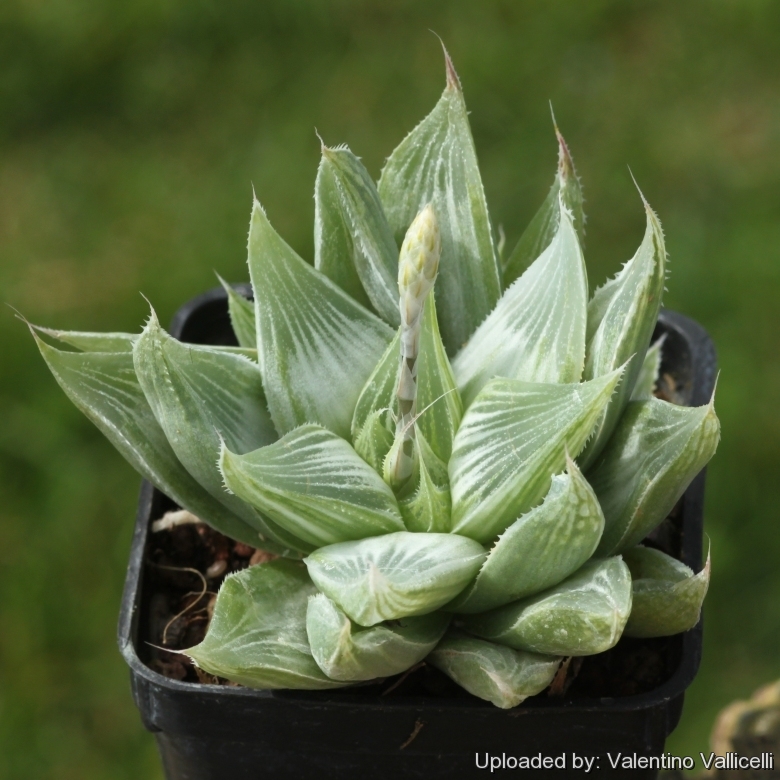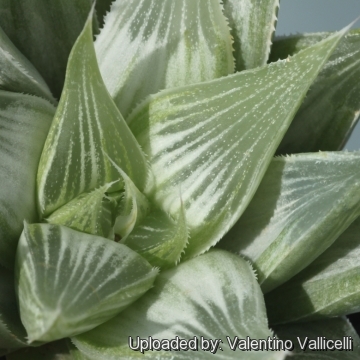




Your support is critical to our success.

Origin and Habitat: Garden origin ( produced cultivar)
Synonyms:
Haworthia magnifica Poelln.
Repert. Spec. Nov. Regni Veg. 33: 239. 1933
Synonymy: 3
- Haworthia magnifica Poelln.
- Haworthia maraisii var. magnifica (Poelln.) M.B.Bayer
- Haworthia retusa var. magnifica (Poelln.) Halda
Haworthia magnifica var. acuminata (M.B.Bayer) M.B.Bayer
Aloe 34(1–2): 6 (1997)
Synonymy: 7
- Haworthia magnifica var. acuminata (M.B.Bayer) M.B.Bayer
- Haworthia acuminata (M.B.Bayer) M.Hayashi
- Haworthia retusa var. acuminata (M.B.Bayer) M.B.Bayer
- Haworthia retusa f. acuminata M.B.Bayer
- Haworthia magnifica var. acuminata f. variegata hort.
Haworthia magnifica var. atrofusca (G.G.Sm.) M.B.Bayer
Natl. Cact. Succ. J. (U.K.) 32(1): 18 (1977)
Synonymy: 2
- Haworthia magnifica var. atrofusca (G.G.Sm.) M.B.Bayer
- Haworthia atrofusca G.G.Sm.
Haworthia magnifica var. dekenahii (G.G.Sm.) M.B.Bayer
Aloe 34(1–2): 6 (1997) et in New Haworthia Handb. 53 (1982).
Synonymy: 3
- Haworthia magnifica var. dekenahii (G.G.Sm.) M.B.Bayer
- Haworthia dekenahii G.G.Sm.
- Haworthia retusa var. dekenahii (G.G.Sm.) M.B.Bayer
Haworthia magnifica var. splendens J.D.Venter & S.A.Hammer
Cact. Succ. J. (Los Angeles) 70(4): 180. 1998
Synonymy: 2
- Haworthia magnifica var. splendens J.D.Venter & S.A.Hammer
- Haworthia splendens (J.D.Venter & S.A.Hammer) M.Hayashi
Description: 'Grey Ghost' is a popular variegated cultivar of Haworthia retusaSN|975]]SN|16708]] with very attractive ghost like appearance. The pale foliage is distinctively patterned with a very stable, consistent, whitish-grey, variegation. It slowly forms offsets, becoming an attractive clump in time. Individual plants can vary a lot depending on the care they've received, especially the amount of light.
It is found on the trade under many synonyms like as: Haworthia turgidaSN|26300]]SN|16777]] f. variegata (variegated), Haworthia turgidaSN|13271]]SN|16777]] "Grey Ghost", Haworthia retusaSN|16708]]SN|16708]] 'Grey Ghost', Haworthia magnificaSN|16777]]SN|13271]] var. acuminata 'Grey Ghost' or Haworthia magnifica var. acuminata f. variegataSN|16777]]SN|26300]]. Some affirm that it may be an hybrid of Haworthia cymbiformisSN|16708]]SN|975]]. Whatever the name, the plant is beautiful, easy to grow and robust.
Inflorescence: Flowering stalk, single, unbranched, erect and wiry; raceme lax about 15 cm long.
Flowers: Small, inconspicuous, tubular, white with green markings.
Subspecies, varieties, forms and cultivars of plants belonging to the Haworthia magnifica group
- Haworthia magnifica Poelln.: has dark green to purplish rosettes with end-area slightly translucent between the veins. It is characteristic for its short green lined buds and flowers and "fish-tail" bud tips. Distribution: Western Cape.
 Haworthia magnifica var. acuminata (M.B.Bayer) M.B.Bayer: Differs from H. magnifica for the leaves that are longer with a stiff truncate end-area. Distribution: North of Gouritzmond, Western Cape.
Haworthia magnifica var. acuminata (M.B.Bayer) M.B.Bayer: Differs from H. magnifica for the leaves that are longer with a stiff truncate end-area. Distribution: North of Gouritzmond, Western Cape. Haworthia magnifica var. acuminata f. variegata hort.: Has leaves stripped with white longitudinal lines.
Haworthia magnifica var. acuminata f. variegata hort.: Has leaves stripped with white longitudinal lines. Haworthia magnifica var. acuminata cv. Grey Ghost: foliage is distinctively patterned with a very stable, consistent whitish-gray variegation. It slowly forms offsets, becoming an attractive clump in time.
Haworthia magnifica var. acuminata cv. Grey Ghost: foliage is distinctively patterned with a very stable, consistent whitish-gray variegation. It slowly forms offsets, becoming an attractive clump in time.- Haworthia magnifica var. atrofusca (G.G.Sm.) M.B.Bayer: Leaves 4 cm long dark blackish green with 3-5 indistinct longitudinal lines and small green tubercles; end-area rather swollen; margin and tip of leaf with small, transparent teeth. Distribution: Western Cape.
- Haworthia magnifica var. dekenahii (G.G.Sm.) M.B.Bayer: Distribution: North and West of Albertinia, Western Cape.
 Haworthia magnifica var. splendens J.D.Venter & S.A.Hammer: It is a slow growing species that stay usually solitary. The leaves shows shades of bronze-rose in half shade culture.
Haworthia magnifica var. splendens J.D.Venter & S.A.Hammer: It is a slow growing species that stay usually solitary. The leaves shows shades of bronze-rose in half shade culture.

Haworthia magnifica var. acuminata cv. Grey Ghost Photo by: Valentino Vallicelli
The gallery now contains thousands of pictures, however it is possible to do even more. We are, of course, seeking photos of species not yet shown in the gallery but not only that, we are also looking for better pictures than those already present. Read More...
Cultivation and Propagation: Haworthia are of easy cultivation and relatively low maintenance, which makes them a good houseplant, and can be an excellent subject for the beginning succulentophile (they can grow easily on window sills, verandas and in miniature succulent gardens where they are happy to share their habitat with other smaller succulent plants, or in outdoor rockeries). Haworthias are winter growers and are dormant in the hottest summer months.
Growth rate: They are relatively fast-growing plants that offsets freely to form small clusters quickly.
Soil: They are tolerant of a wide range of soils and habitats, but prefer a very porous potting mix to increase drainage. A non-acid soil is ideal. You can grow a plant in a 10-15 cm pot for years and have perfectly happy plants. For best results, use a shallow pot.
Exposition: The plant needs light shade to shade. All Haworthia forms that are green, especially included the variegated forms, will prefer filtered light.
Watering: During the hot summer months, the soil should be kept moist but not overly wet. During the winter months, water only when the soil becomes completely dry. Wet soil quickly causes root and stem rot, especially during chilly winter months. No water should ever be allowed to stand around the roots. Low ambient humidity is always needed.
Fertilization: The plants are fertilized only once during the growing season with a balanced fertilizer diluted to ½ the recommended strength.
Hardiness: Although the plant will survive mild frost if kept dry (hardy as low as -5° C) it should be protected from severe cold and prolonged frost conditions.
Rot: Rot is only a minor problem with Haworthia if the plants are watered and “aired” correctly. If they are not, fungicides won't help all that much. Care must be given in watering, keeping them warm and wet while growing, and cooler and dry when dormant.
Remarks: Haworthias are best planted in a shaded and airy part of the greenhouse, and not too close to the glass roof or sides of the house as the plants can overheat during hot spells.
Propagation: Haworthia are easily propagated by the removal of offshoots or by leaf cuttings in spring or summer. To propagate by leaf cuttings, remove a leaf and let it lie for about one month, giving the wound time to heal. Then lay the leaf on its side with the basal part buried in the soil. This leaf should root within a month or two, and small plants will form at the leaf base. They can also be grown from seed.
| Your Actions | |
|---|---|
| Back to Haworthia index | |
| Back to Aloaceae index | |
 |
Back to Succulents Encyclopedia index |
Privacy stantement - Terms and conditions - How to cite - About us - Feedback - Donate



